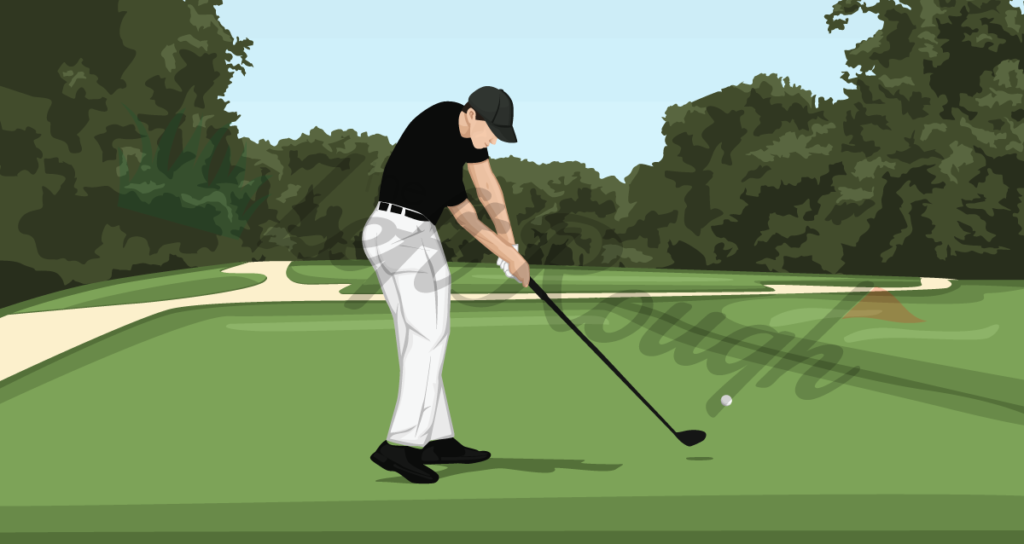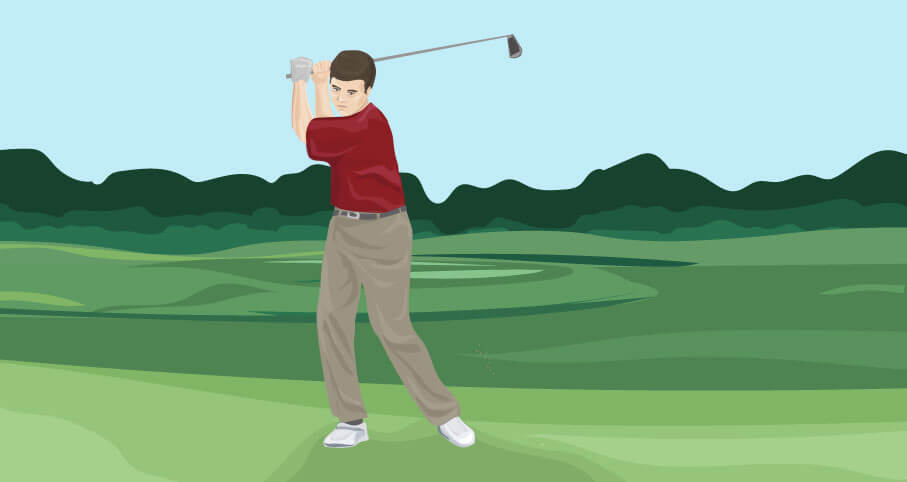For a lot of amateur golfers, the role of the legs during the golf swing is often overlooked. Proper use of legs in golf swing is something that doesn’t sound like it’s super important, but it definitely is something worth practicing.
Amateurs tend to think of the golf swing as mostly an upper body motion. The problem with that approach is that it misses out on a source of great power and control. The legs in the golf swing are the primary movers, whereas the arms and torso follow, the legs lead.
Making sure that your legs are in the proper position throughout your golf swing will allow you to unleash power that you never knew you had. Not only that, but it’ll create a golf swing that is much more fluid, natural, relaxed, and easy to control.
How All the Body Parts Move: Below the Belt Edition
Correct Hip movement in the Swing
The first thing to pay attention to in your lower body is the movement of your hips and waist. As you start your golf swing, you’ll easily notice the movement of your arms; the hip turn is more subtle than that, but not to be ignored.
- Focus your attention on the outsides of each hip. At address, one side is pointing towards the target and the other is pointing in the exact opposite direction. As the swing begins, you want to slowly move to point your front hip bone down into the ground. It won’t point directly down at your golf ball, but it will be a shift from the original position that was pointing towards the target. You’ll also notice that the back-hip bone moves to point slightly up in the air.
- Another way to think about this movement is to imagine the shaft of a golf club running directly through your waist. You want that club to get to the point where it is pointing down into the ground a couple feet in front of your golf ball and into the sky on the other end. This movement will allow you to coil your upper body around your spine, creating torque, which is unleashed on the golf ball for more power.
- Once you get to the top of your golf swing and have turned your hips as much as you can, while remaining fairly comfortable, you’ll need to start your downswing. Whereas in the backswing, your arms are the first thing to move, on the downswing, your hips and waist are the first thing to start to return to impact.
Your goal is to, not only, turn your hips back to their original position, but to also slide them slightly forward towards your target. This, combined with the twisting of your hips creates more power than your arms ever could.
This truly is the key to more distance; creating torque with your hips and waist while creating forward movement into and through impact.

Proper Lead Leg Footwork
Now, if we look a little lower, we have to talk about the hip and leg movement in the golf swing; from the upper knee area and down to your foot.
First, we’ll focus on the leg that is closest to your target; the left leg for a right-handed player:
- As you take the club back and the hips twist, you’ll be forced to bend your front knee in order to facilitate the turn.
- Your knee should dip down slightly towards the ground and also backwards towards your back leg.
- This will allow you to have more freedom of movement in the hips.
When it comes to the front foot, there’s a lot of debate. In general, the older generation of players will advocate for a slight raising of the front heel off the ground through the backswing. Again, this allows even more freedom of movement and can get you more power. Take a look at swings from Jack Nicklaus and Phil Mickelson for an example of this technique.
On the other hand, the younger generation of players tend to like to keep the left foot flat on the ground during the entire swing. The correct answer to this debate is, whatever works best and is most comfortable for you. The argument hinges on the ability of a player to return to the correct impact position.
Lifting the front foot in the backswing can cause a player to sway backwards and forwards too much during the swing, and thus, make solid impact more difficult to create consistently.
If you are able to create solid impact when you raise your front heel during the backswing, then go for it. That being said, if you struggle with consistent impact, I’d recommend going with the “new age technique” of keeping the front foot flat on the ground throughout the entire golf swing.
On the downswing, the front leg and foot will return to their original address position and stay there throughout the rest of the swing, including the follow-through. In this process, knee straightening will occur and remain throughout the rest of the swing. This front leg is the stable base of your swing. It’s where you’ll balance most of your weight when you’re finished. So, your goal is to create a firm and sturdy foundation all the way through that leg through impact.
Correct Trail Leg Footwork
When it comes to the back leg and foot, there is significantly less movement than the front during the backswing.
Since the front knee is bending, the back knee will need to stay straight in order to get the correct tilt and twist to your swing. Instead of bending, your back knee will turn or twist slightly in the direction away from the ball. This back leg is loading itself during the back swing in order to explode through the impact position.
Once the downswing begins the knee bend changes. It was previously in your front leg, but as the downswing unfolds, your back knee will bend and move towards the golf ball.
You can think of this back leg as an attacker. It is attacking the ball by bending and flying directly at the impact position. Your back heel ought to start coming off the ground through impact until you find yourself standing up on the toe of your back foot in the finish position.
Pro tip: How to improve accuracy through footwork
One way to improve your aim and direction is to try and keep your back foot flat on the ground all the way until impact. Only then will you allow your back heel to come up in the air.
Common Footwork Mistakes
There are some common mistakes that amateur golfers will make when it comes to the movement of the legs during the golf swing.
The first, and probably most prevalent, is that they’ll keep their lower body too quiet, or motionless, throughout the swing. Like I said earlier, many golfers believe that the golf swing is primarily an arm and upper body movement, but that’s incorrect. It’s a full-body movement that requires the use of the legs in order to reach its fullest potential.
The second common mistake, that I briefly mentioned above as well, is that golfers will sway backwards too much with their lower body. The movement of the hips, legs, and feet is not about swaying backwards. Instead, it’s about twisting around your body to create torque.

A common mistake here is that too many golfers try to sway backwards in their swing in order to create power, but this typically just makes it more difficult to return to the impact position successfully. It throws off a player’s balance and timing, which is not something we ever want to lose in a golf swing.
Finally, some golfers struggle with executing the proper foot work. They’ll lift the wrong heel at the wrong time or leave a heel flat when it should be lifted. The proper footwork in the backswing is that the back foot stays completely flat and the front heel can either stay completely flat or the heel can raise slightly.
Again, if consistent contact is an issue, then the front heel should always stay flat. Then, through the down swing, the back heel comes up slightly through impact until it is fully up in the air in the finished position. The front heel stays completely flat throughout the entire downswing and finish position. These moves will help get the correct weight shift, power, and direction out of your shots.
Drills to Engrain Proper Footwork and Leg Action in the Golf Swing
There are a couple great drills to use your legs in the golf swing that can help improve your overall game.
- One of the best is to grab a golf club with both hands.
- Put one hand on the grip and one down by the head.
- Then rest the club across your waist.
- Take imaginary “swings” while just focusing on the twist of the waist in the backswing.
- You’ll notice that, in the backswing, the club ought to point down to the ground in front of the ball and up to the sky behind the ball.
- Then, on the imaginary downswing, try to point the back end of the club toward the ball at impact.
This drill will accurately simulate the “attack” position of the back leg throughout impact. This next drill you can practice to simulate good lower body action.
- Grab a golf ball in your throwing hand.
- Set up like you’re going to hit a golf ball, but instead, throw the golf ball like a baseball.
- Pay attention to the hip turn forward.
This tends to be a good, natural, movement that people can grasp easier than a golf swing movement. You want your lower body in a golf swing to look very similar to what it looks like to throw a baseball.
Putting it All Together
I firmly believe that if you are able to incorporate these tips and drills into your practice and golf game, you’ll see a significant improvement in your distance and direction, two things we could all use a little improvement on.
The movement of the lower body can be a little complicated at first, but once you simplify it, relax, and move in the way your body was naturally designed to move, you’ll find that it make the golf swing all fit together much easier.


This is a very good and clear written article. Thanx
I really like the explanation of the rear leg rotating slightly clockwise to hold its position to impact ! That also should keep you from coming over the top, as the saying goes.
I’ll add this into my teaching lessons. David Lee’s Gravity golf doesn’t explain this move. I can’t wait to try it myself !!